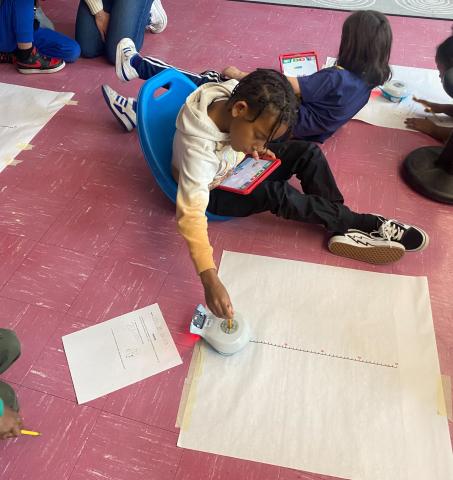Body
Image

Transforming teaching mathematics with culturally relevant coding activties
The primary goal of our project is to improve achievement and interest in mathematics of New York City Black and Latinx students in grades 1-3 to build a foundation for interest and success in future STEM careers. We are working with two Title I schools in Brooklyn, NY, where we have 12 teachers-participants teaching in ICT (large percentage of students with disabilities) and bilingual (large percentage of English language learners) classrooms. In the first year of the project, the project team and the teachers co-designed a total of 146 culturally-relevant robot coding mathematics activities. This year the teachers are pilot-testing developed activities in their classrooms while participating in monthly grade-based PD workshops where they discuss the ways of introducing activities to the students and reflect on implemented activities. We also engaged STEM professionals of color to come to schools and share their stories with the students. In its design, this project seeks to build on key lessons from research: that integrating coding and robotics into math instruction in elementary school can help make math more engaging and relevant to the students; and that on-site, intensive professional development (and co-designed curricular activities) facilitate teacher learning, development of instructional repertoires aligned with culturally relevant pedagogy tenets, and take-up of mathematics reform activities.
Pillar 1: Innovative Use of Technologies in Learning and Teaching
In the classrooms, the teachers are developing an understanding of how to support students to problem solve through robot coding while engaging students in rich and mathematically meaningful activities that reflect key principles of culturally-relevant mathematics pedagogy. One example of this is in a lesson where students practice measurement and calculations of area in the context of serving as architects of a new playground. In doing measurements and drawings to test results with the Finch robot, students test their
Pillar 2: Partnerships for Career and Workforce Preparation.
Our project addresses STEM workforce development in two ways: 1) using robots in math exposes students to the simpler version of tools adults use in STEM careers - our partner, Vision Education & Media (VEM), a community-based STEM education organization, provided mentors that support teachers and students in the classrooms., and 2) culturally relevant pedagogy and guest lectures by STEM professionals of color helps students forming math identities in imagining future STEM careers.
Pillar 3: Strategies for Equity in STEM Education
Using culturally relevant mathematics coding activities will reveal cultural wealth of Black and Latinx students and improve their knowledge and attitudes toward math building foundation for interest and success in future STEM careers. The project led to development of teacher professional learning communities in two schools with large percentages of underserved students. These teachers will be affecting more and more students in diverse NYC neighborhoods beyond the length of the project.

Discipline(s)
Mathematical sciences
Target Gradespan(s)
Elementary school (K-5)
Target Participant(s)
Youth / students
Educators
Girls (or women)
Black/African American participants
Hispanic/Latino participants
English learners
Students eligible for free lunch or reduced-price lunch
Participants with disabilities
Project Setting(s)
Formal Education
Category
Developing and Testing Innovations (DTI)